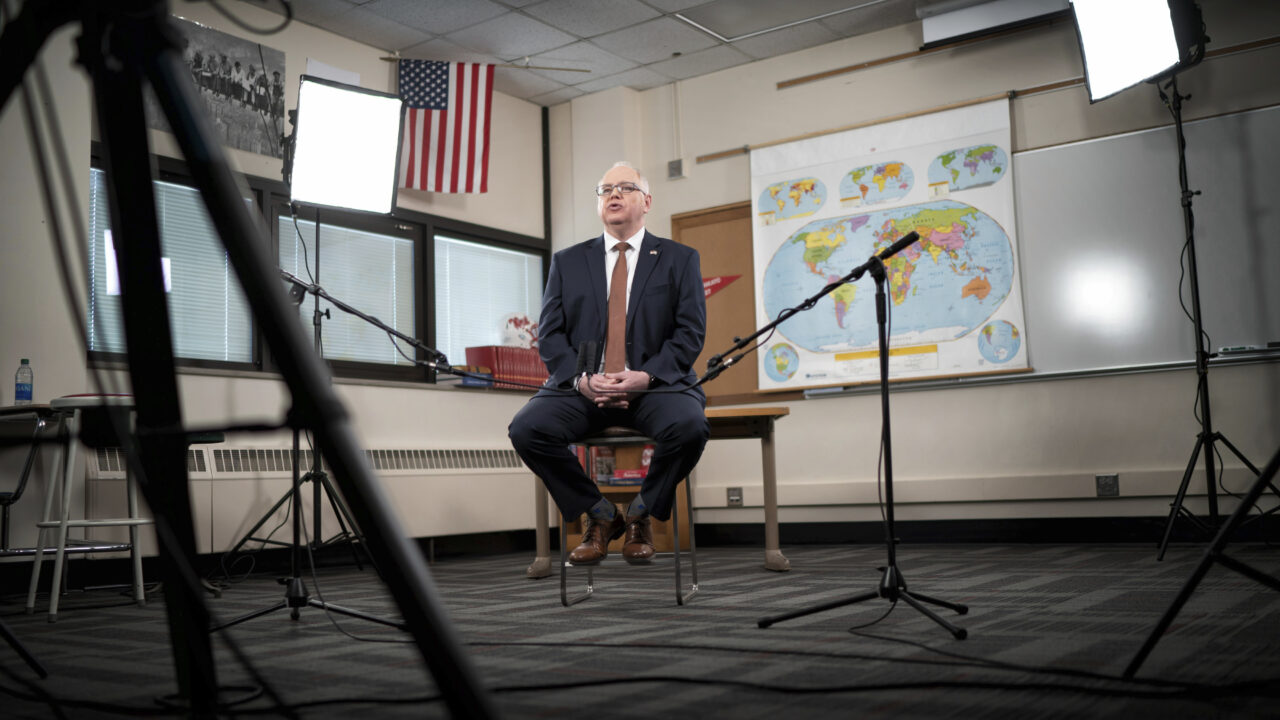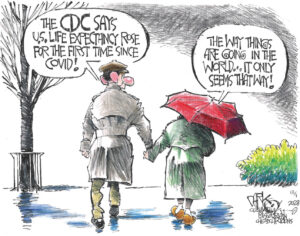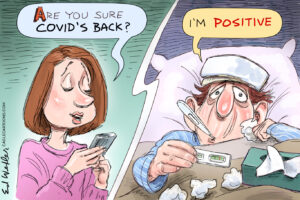Tim Walz: Progressive Map Nerd
The Minnesota governor is of the belief that "conveying data to people in a complex way helps to build trust.” In 2021, Minnesota Gov. Tim Walz delivered his State of the State address from his old classroom at Mankato West High School. (Star Tribune via AP/Glen Stubbe)
In 2021, Minnesota Gov. Tim Walz delivered his State of the State address from his old classroom at Mankato West High School. (Star Tribune via AP/Glen Stubbe)
Minnesota Gov. Tim Walz really, really likes maps.
The former Mankato, Minnesota, geography teacher, now a vice presidential candidate, identifies as a “GIS nerd” and proclaimed Nov. 15, 2023, as Geographic Information Systems day, writing that an understanding of maps and data “helps community leaders and government officials make data-driven decisions” governing important policy issues like education, public safety and the environment.
Over the past several years, Walz has given several addresses at conferences hosted by ESRI, the company that makes leading GIS software ArcGIS. Part stump speech and part GIS infomercial, the talks underscore how maps shaped Walz’s understanding of the world as a young educator and member of Congress. and how he now relies on them as the “tools” to implement the ambitious policy agenda crafted by Minnesota’s Democratic-Farmer-Labor Party trifecta this term.
“The end product of these maps is a more sustainable economy, a more sustainable environment and lifting up of people’s lives in a way that they can thrive,” he said as part of the keynote of an ESRI conference in mid-July.
Geography in the classroom and in Congress
Walz said he was an early adopter of GIS software in the 1990s, using it, among other things, to teach high school students about the Holocaust.
He had his students build maps of the contemporary world using different layers of data that scholars believed could factor into modern-day genocides. “They started looking at food insecurity, potential drought, just like the U.N. was doing around famine early warning,” Walz said.
“The end product of these maps is a more sustainable economy, a more sustainable environment, and lifting up of people’s lives in a way that they can thrive.”
In 1993, he asked his sophomores where they thought the next genocide might happen, based on the geographic data. They pinpointed Rwanda. The following year, the Rwandan Genocide occurred. The New York Times interviewed some of the students involved in the project in 2008, when Walz was a U.S. congressman.
Walz also criticized his former congressional colleagues for their lack of knowledge about global geography. He spoke of “blank stares” in an Armed Services Committee hearing when he brought up the Durand Line, referring to the often disputed border between Afghanistan and Pakistan.
“A geographically illiterate member of the United States Congress is a very scary proposition,” he said.
All the governor’s maps
Walz says that he now relies heavily on maps to both share information with constituents and to target policy interventions.
“As a governor, the ability to use what I knew about mapping and the visual display of data to convey complex issues, to affect change amongst people, is really important,” he said. The early days of the COVID-19 pandemic, when maps of case counts and geographic spread were a ubiquitous part of newscasts and policy discussions, underscored this point.
“GIS helps build trust,” he said. “Conveying data to people in a complex way helps to build trust.”
“A geographically illiterate member of the United States Congress is a very scary proposition.”
Walz also boasted about St. Paul’s map of lead pipes that allows homeowners to look up their addresses and schedule service to get the pipes replaced. “This is the interaction between your map and policies, and a united world and good outcomes for people,” he said.
Walz also says maps help implement the nitty-gritty details of otherwise abstract policy. “You have to have a plan” for “how we’re doing power and economic justice and environmental justice,” he said. “The tools for that plan are GIS.” Those tools “transfer a vision of a fair society into one that actually has results.”
At the keynote, Walz shared something called the Minnesota Executive Map Portfolio, a collection of online maps showing data on some of his policy priorities: children and families, the climate and the economy.
He spoke at length about a map of peat bogs (“Minnesota has the second-most of these, only behind Alaska”); one showing child tax credit filing versus eligibility (“We had to get out there and find out who’s not filing for taxes and break it down to the street level”); and a map of youth job skills training rates (“Matched up with the employers who are there, overlaid with our high school graduation rates, means fewer students drop through the cracks.”)
Walz also has strong feelings about maps he’s not particularly fond of. In 2023, he told an ESRI audience that “we need to find the first person who put that red-blue map up and beat the hell out of them for putting that on, because it divided the country. And it did not show the nuance that GIS shows.”
Those red and blue maps were the subject of off-the-cuff remarks that became infamous among Walz’s Republican opponents. In 2017, he was speaking at a candidate roundtable on comedy show T2P2 when he brought up the urban-rural partisan divide.
“You have to have a plan [for] how we’re doing power and economic justice and environmental justice.”
“You see those maps. Red and blue, and there’s all that red across there. And Democrats go into depression over it. It’s mostly rocks and cows that are in that red area because of demographics,” he said. “I’m a geographer. But it doesn’t change the fact that moving toward an urban population left a lot of areas where they were wondering, ‘Where was the person speaking for them?’”
Republicans circulated an abbreviated clip of the “rocks and cows” comment and turned it into an attack line.
But overall, Walz tends to speak rapturously about the power of good maps to bring about social change. “I know I’m preaching to the choir, but the choir needs to sing,” he told ESRI in 2024. “This stuff works. This stuff makes a difference. The map is wonderful to look at. It’s exciting.”
As an ESRI executive put it while introducing Walz to the crowd of GIS enthusiasts and map nerds: “He’s one of us.”
Your support is crucial...As we navigate an uncertain 2025, with a new administration questioning press freedoms, the risks are clear: our ability to report freely is under threat.
Your tax-deductible donation enables us to dig deeper, delivering fearless investigative reporting and analysis that exposes the reality beneath the headlines — without compromise.
Now is the time to take action. Stand with our courageous journalists. Donate today to protect a free press, uphold democracy and uncover the stories that need to be told.






You need to be a supporter to comment.
There are currently no responses to this article.
Be the first to respond.